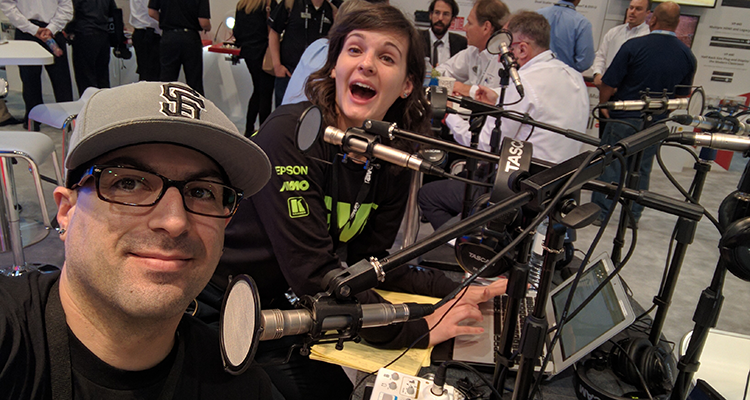InfoComm Presents 2016 Awards with Keynote Speaker Stephen J. Dubner
 The week of exciting exhibitions and new technologies kicked off at The Westgate Paradise Event Center in Las Vegas on Tuesday June 10, 2016. The opening ceremonies held began with a presentation of the InfoComm International Awards. Applications were reviewed by a dedicated Awards Committee to determine the following 2016 winners:
The week of exciting exhibitions and new technologies kicked off at The Westgate Paradise Event Center in Las Vegas on Tuesday June 10, 2016. The opening ceremonies held began with a presentation of the InfoComm International Awards. Applications were reviewed by a dedicated Awards Committee to determine the following 2016 winners:
- Mackey Barron Distinguished Achievement Award- David Bright, Kramer
- Harald Thiel Volunteers of the Year – Hope Roth, CTS, Crestron AND
- Christa Bender, CTS, Pivot Communications
- Women in AV Award- Rose Shure, Shure Incorporated
- Young AV Professional Award- Kelly Perkins, CTS, AVI Systems
- Young AV Professional Award- Josh Srago, CTS, TEECOM
Following the presentation of these prestigious awards, a moment of silence was held during the ceremony for the incredibly valued members of the AV industry who are recently no longer with us. In the past year, several leaders were lost including Mackey Baron for whom the Distinguished Achievement Award has been renamed to honor the impact and legacy he had on the tech industry. The family and industry leaders who carry on the passion and excellence of the leaders lost are appreciated and valued in the industry as a representation of those individuals lifetime commitments.
InfoComm’s Chief Operating Officer, Al Damico took the stage to introduce the award winning author, journalist, and tv personality, Stephen J. Dubner. To a host of applause from the estimated 2500 industry attendees, the famed co-author of the Freakonomics series launched his highly entertaining take on human behavior prediction and the potential to solve problems relating to this using communication technology applications.
As the self-proclaimed “last thing standing between the audience and the first cocktail of the evening,” Stephen J. Dubner sort of made his grand point first. It is difficult but not impossible to determine effective incentives for changing human behavior. He fleshed it out by offering a few anecdotes which outlined some of the complications of attempting to predict what people are going to like and not like. These mostly animal related references also shed light on some of the false assumptions about problem solving that can be avoided by asking difficult questions.
Dubber admitted that predicting the future is hard, and even the experts mostly get it wrong. But his advice to those in the industry who are constantly seeking to better anticipate the behaviors of future consumers was fairly simple. First, have a little humility about what you know and do not know. Secondly, make an effort to access information that reflects the reality of human behavior, not how humans say they will respond in a given situation, but how they actually do. And third, use that data to understand the incentives that make people change their behavior. In essence, tune into the reality that exists and not the one that you want to exist, that is the “what”. Then, analyze the existing reality you have identified to determine the “why”.
To further understand these insights, Dubner asked the audience to raise their hands if they do not wash their hands after using a public restroom. Seeing no one raise their hands, Dubner proclaimed that approximately 30% of the room was lying. This is because in order to gather accurate data that reflects reality you must be crafty. You must take into consideration the circumstances under which you gather data because that has a great deal to do with the reliability of that data. We are emotionally and psychologically inclined to ignore reality and seek out data that confirms what you have already decided. Dubner hilariously explains his creative solutions to accounting for accurate hand hygiene. He simply lingers by the sink in the public restrooms at airports and tallies the men who come in and out without washing their hands. The ratio of this particular subset was 70% do and 30% do not.
After this in-house example of how situation can distort the reality of data, Dubner explained how economists talk about declared preferences and revealed preferences. The former being what people say they like or do and the latter being what they actually do. In the industry, every time you introduce a new technology, you’re asking a consumer to change their behavior. However, even if they say they are eager to engage with the new product this bears almost no realistic value. Dubner offers some pointed advice using the hand hygiene example about why people do not respond to incentives in the way you intended them to. There is a lot of trial and error involved in determining the root incentives of human behavior. Sending out Public Service Announcements to educate seems to have no impact on hand hygiene. Setting strict expectations for 100% hand hygiene compliance also does nothing to change the ratio. Positive reinforcement via incentives works under supervision but not outside the supervised realm, thus also not affecting the ratio. A technical solution involving an enlarged photo of hand bacteria strategically placed proved the optimal solution for the hand hygiene conundrum. Dubner noted that this solution was arrived at by following up on the idea of the quiet person in the room. Citing the courage to propose out of the box solutions to a room of noisy personalities as a hugely influential element of the problem solving process because the level of your voice does not reflect the credibility of your ideas. To culminate this idea of redefining the problem to suit the existing reality, Dubner said: “The most amazing inventions and innovations come from those courageous people who ask outlandish questions. You must respect those people.”
Dubner tells one final story about a researcher attempting to get tenure at Yale using a “currency experiment”. The title of the experiment does little to belay the actuality of it. Economist Keith Chen was seeking ways to circumvent the problem of humans not always doing what they say by using monkeys rather than humans. Creating a pseudo-economy by training monkeys to use money and then tracking how they spend it. Since monkey’s interests are limited to food and sex, these experiments revealed more than one parallel to human behavior, minus the humans. In essence, the monkeys did learn to exchange money for food. In the process of uncovering the monkey’s food preferences, and the impact of price shocks on those preferences, the monkeys revolted and did something unexpected with the coins they were given. Essentially, Chen facilitated the first recorded instance of monkey prostitution.
How does this entertaining case study relate to the use of new communication technologies in human behavior? Unclear, they’re monkeys. But, in the words of Stephen J. Dubner, “that concludes whatever happened here today”.
The catered reception following the opening ceremony was DJ’d by Pedro LE Bass.




